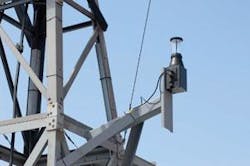Navy evaluates 360-degree optical sensor to enhance shipboard defenses against swarms of small boats
By John Keller
SAN DIEGO - U.S. Navy officials are evaluating a 360-degree visible-light and infrared surveillance system from RemoteReality Corp. in Westborough, Mass., for potential integration on surface warships to guard against swarms of small attack boats that terrorists typically might employ.
RemoteReality’s sensor, called the OmniAlert360, is part of a program called the Fast Inshore Attack Craft (FIAC) Defense System from the Lockheed Martin Corp. MS-2 Littoral Ships and Systems segment in Baltimore.
Navy officials evaluated the utility of the OmniAlert360 sensor system aboard surface ships involved in the Seahawk 07 exercises off San Diego last August.
“It is our hope that the Navy will implement these systems in their modernization plans for shipboard defense,” says Timothy Fouts, manager of business development at Lockheed Martin MS-2 Littoral Ships and Systems.
The OmniAlert360 system has a special kind of mirror that captures a 360-degree field of view. The system corrects optical aberrations, which are similar to the optical distortion of a fisheye lens, says James Ionson, chief executive officer of RemoteReality.
The view from the mirror and lens can move to a CMOS sensor for further electronic processing. “We display on a computer screen two strips that are 180 degrees in front and 180 degrees in back,” Ionson explains. “Operators can see anything line of sight in a sphere, except where the line of sight is obstructed by the ship itself.”
The sensor is fitted to the masts of surface combatants such as Navy Ticonderoga-class cruisers, Arleigh Burke-class destroyers, and the future Littoral Combat Ship to help Navy personnel detect, analyze, classify, and target approaching swarms of hostile attack boats.
The system can detect as many boats that are in its field of view. “The camera is persistent at staring in the 360-degree domain; you can’t hide from this thing,” Ionson says. The OmniAlert360 is available with two kinds of cameras-one that detects visible low-light, and the other that detects thermal infrared energy for operations at night.
The visible-light and night-vision cameras cannot be combined in the same unit, however, because the cameras require different sets of lenses. To get 24-hour coverage, the FIAC system could co-locate daylight and night-vision systems, Ionson says.
“This 360-degree view is something the sailors don’t have,” says Lockheed Martin’s Fouts. If the Navy decides to deploy the FIAC Defense System, these systems could be deployed with the U.S. surface fleet by 2010 or 2011, he says.
The concept behind the FIAC Defense System is to give Navy ships more time to detect and gauge the intent of groups of small boats. The FIAC Defense System is to extend the surveillance radius of the horizon out to at least five nautical miles.
In the future, Lockheed Martin experts are interested in integrating smaller versions of the OmniAlert360 system aboard unmanned aerial vehicles and networking the sensor information over satellite and other wireless networks to extend surface coverage even further, Fouts says.

